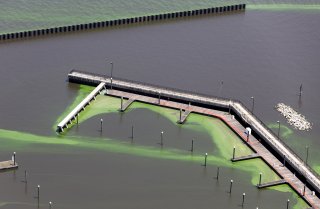Algal Toxin Rule and Harmful Algal Blooms in Urban Environments Webinar
- Watch the webinar recording (March 26, 2024)
- Small Drinking Water Systems Webinar Series
About the Webinar

1. Establishing an Algal Toxin Rule and Regulatory Program in Rhode Island, an Informal Case Study
As the severity and impact of Harmful Algal Blooms (HABs) increasingly pose risk to human health, one frequent topic of discussion is when and/or how to adopt regulations accordingly, and in what capacity. The numerous factors that require consideration – agency jurisdiction, criteria thresholds, balancing bloom/toxin prioritization, the need for programmatic support, etc. – can be challenging barriers to address without the established federal counterparts that are in place for many other drinking water rules and programs. In 2019, Rhode Island was one of the earliest states to establish a HAB/cyanotoxin rule in the state public drinking water regulations, which also required the development of surrounding program infrastructure.
This presentation serves as a brief, small-scale case study of a state-level Algal Toxin program from its inception onward, including topics such as an overview of the rule’s regulatory language, toxin selection and health limits, implementation, challenges, and other resources/information.
Presenter: Shannon Harrower-Nakama, Rhode Island Department of Health. Shannon is an environmental scientist with the Rhode Island Department of Health’s Center for Drinking Water Quality. She currently serves as the center’s Source Water Protection Program lead and manages the Algal Toxin Rule under the state’s public water system regulations. Part of her role has been to implement the Algal Toxin Rule from the point it was first incorporated in 2019. and establish the Rule’s program from the ground up. She also worked to develop strong collaborative partnerships with other agencies, such as Rhode Island’s Department of Environmental Management’s surface water monitoring and protection programs, which have been integral to the program’s success.
2. Insights on Harmful Algal Bloom Dynamics in Urban Lakes & Introduction to Benthic Sample Preparation
Algae are a natural component of aquatic ecosystems; however, when present in large quantities as "blooms", they can pose a significant potential threat to human and ecological health. These harmful algal blooms (HABs) are often composed of microorganisms known as cyanobacteria, some of which have the potential to produce toxins that can cause adverse health effects in humans and animals through the contamination of waterways used for recreational purposes and as drinking water supplies.
HABs are understudied in the urban environment. This presentation discusses the investigation of urban lakes in three metropolitan areas to determine if there are parameters that are unique to these lakes and investigate the correlation between urban watershed characteristics and cyanobacterial HABs.
Presenters:
Heath Mash, EPA Office of Research and Development. Heath is a chemist with EPA’s Office of Research and Development, Center for Environmental Solutions and Emergency Response, where he specializes in analytical chemistry with regards to drinking water treatment. In addition to cyanobacterial toxins work, his work has included estrogenic and androgenic compounds and disinfection byproduct studies.
Toby Sanan, EPA Office of Research and Development. Toby is a research chemist with EPA’s Office of Research and Development, Center for Environmental Solutions and Emergency Response, where he has been working in the area of analytical method development for over ten years. Presently his research is focused on detecting and quantifying contaminants of emerging concern, including PFAS and cyanobacterial toxins, using mass spectrometric techniques including high resolution and non-targeted methods. He is leading the EPA’s effort to develop a total oxidizable precursor assay method for helping to fill the mass gap in PFAS measurement and is also involved in work related to the study of harmful cyanobacteria and their associated toxins.
